CHEVROLET ASTRO 2003 Owner's Manual
ASTRO 2003
CHEVROLET
CHEVROLET
https://www.carmanualsonline.info/img/24/55882/w960_55882-0.png
CHEVROLET ASTRO 2003 Owner's Manual
Trending: brakes, engine overheat, maintenance schedule, refrigerant type, spark plugs replace, remove seats, tire pressure
Page 21 of 386
In most states and in all Canadian provinces, the law
says to wear safety belts. Here’s why:
They work.
You never know if you’ll be in a crash. If you do have
a crash, you don’t know
if it will be a bad one.
A few crashes are mild, and some crashes can be
so
serious that even buckled up, a person wouldn’t survive.
But most crashes are in between. In many of them,
people who buckle up can survive and sometimes
walk away. Without belts they could have been badly
hurt or killed.
After more than
30 years of safety belts in vehicles.
the facts are clear. In most crashes buckling up
does matter
... a lot!
Why Safety Belts Work
When you ride in or on anything, you go as fast as
it goes.
Take the simplest vehicle. Suppose it’s just a seat
on wheels.
1-14
Page 22 of 386
Sic-1
'I! uo au0aUlos ]nd
Page 23 of 386
The person keeps going until stopped by something.
In a real vehicle, it could be the windshield ...
or the instrument panel ...
1-16
Page 24 of 386
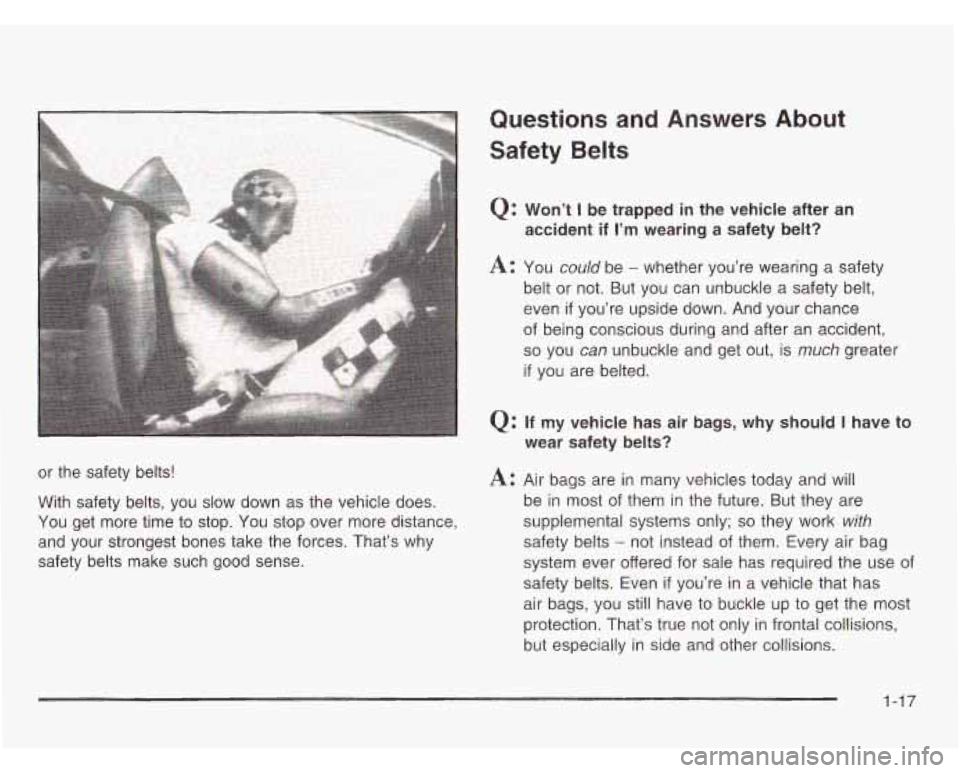
Questions and Answers About
Safety Belts
Q: Won’t I be trapped in the vehicle after an
accident if
I’m wearing a safety belt?
A: You could be - whether you’re wearing a safety
belt or not. But you can unbuckle a safety belt,
even
if you’re upside down. And your chance
of being conscious during and after an accident,
so you can unbuckle and get out, is much greater
if you are belted.
Q: If my vehicle has air bags, why should I have to
wear safety belts?
or the safety belts!
With safety belts, you slow down as the vehicle does,
You get more time to stop. You stop over more distance,
and your strongest bones take the forces. That’s why
safety belts make such good sense. A: Air bags are in many vehicles today and will
be in most of them in the future. But they are
supplemental systems only;
so they work with
safety belts - not instead of them. Every air bag
system ever offered for sale has required the use
of
safety belts. Even if you’re in a vehicle that has
air bags, you still have to buckle up to get the most
protection. That’s true not only in frontal collisions,
but especially in side and other collisions.
1-17
Page 25 of 386

Q: If I’m a good driver, and I never drive far from
home, why should
I wear safety belts?
A: You may be an excellent driver, but if you’re in an
accident
- even one that isn’t your fault - you and
your passengers can be hurt. Being a good
driver doesn’t protect you from things beyond your
control, such as bad drivers.
Most accidents occur within
25 miles (40 km)
of home. And the greatest number of serious
injuries and deaths occur at speeds of less than
40 mph (65 km/h).
Safety belts are for everyone.
How to Wear Safety Belts Properly
This part is only for people of adult size.
Be aware that there are special things to know about
safety belts and children. And there are different
rules for smaller children and babies.
If a child will be
riding in your vehicle, see
Older Children on page 1-35
or lnfants and Young Children on page 1-38. Follow
those rules for everyone’s protection.
First, you’ll want to know which restraint systems your
vehicle has.
We’ll start with the driver position.
Driver Position
This part describes the driver’s restraint system.
Lap-Shoulder Belt
The driver has a lap-shoulder belt. Here’s how to
wear it properly.
1. Close and lock the door.
2. Adjust the seat so you can sit up straight.
To see how, see “Seats” in the Index.
1-18
Page 26 of 386
3. Pick up the latch plate and pull the belt across you.
4. Push the latch plate into the buckle until it clicks.
Pull up on the latch plate to make sure it is
secure. If the belt isn’t long enough, see
Safety
Belt Extender on page 1-34.
Make sure the release button on the buckle is
positioned so you would be able to unbuckle the
safety belt quickly
if you ever had to.
Don’t let it get twisted.
The lap part of the belt should
be worn
low and snug on
the hips, just touching the thighs. In a crash, this applies
force to the strong pelvic bones. And you’d be less likely
to slide under the lap belt. If you slid under it, the belt
would apply force at your abdomen. This could cause
serious or even fatal injuries. The shoulder belt should go
over the shoulder and across the chest. These parts of
the body are best able
to take belt restraining forces.
The safety belt locks
if there’s a sudden stop or crash,
or
if you pull the belt very quickly out of the retractor.
1-19
Page 27 of 386
Shoulder Belt Height Adjuster To move it down, push it in at the top of the arrows
and move the height adjuster to the desired position.
Before you begin to drive, move the shoulder belt
You can move the adjuster up just
by pushing up on the
adjuster to the height that is right for you.
shoulder belt guide. After you move the adjuster to
your shoulder
1-20
Page 28 of 386
Q: What's wrong with this?
A: The shoulder belt is too loose. It won't give nearly
as much protection this way.
You can be seriously hurt if your slI,ulder belt
is too loose. In a crash, you would move
forward too much, which could increase injury.
The shoulder belt should fit against your body.
1-21
Page 29 of 386
Q: What's wrong with this?
A: The belt is buckled in the wrong place.
'I I can be serious injured i OUL --elt is
buckled in the wrong place like this. In a crash,
the belt would
go up over your abdomen.
The belt forces would be there, not at the
pelvic bones. This could cause serious internal injuries. Always buckle your belt into the
buckle nearest you.
1-22
Page 30 of 386
Q: What’s wrong with this?
1
A: The belt is over an armrest. You
can be seriously injured
.. jour bell ,oes
over an armrest like this. The belt would be
much too high.
In a crash, you can slide under
the belt. The belt force would then be applied
at the abdomen, not at the pelvic bones, and
that could cause serious or fatal injuries. Be sure the belt goes under the armrests.
1-23
Trending: torque, oil capacity, sensor, key, mirror, fuel cap, oil
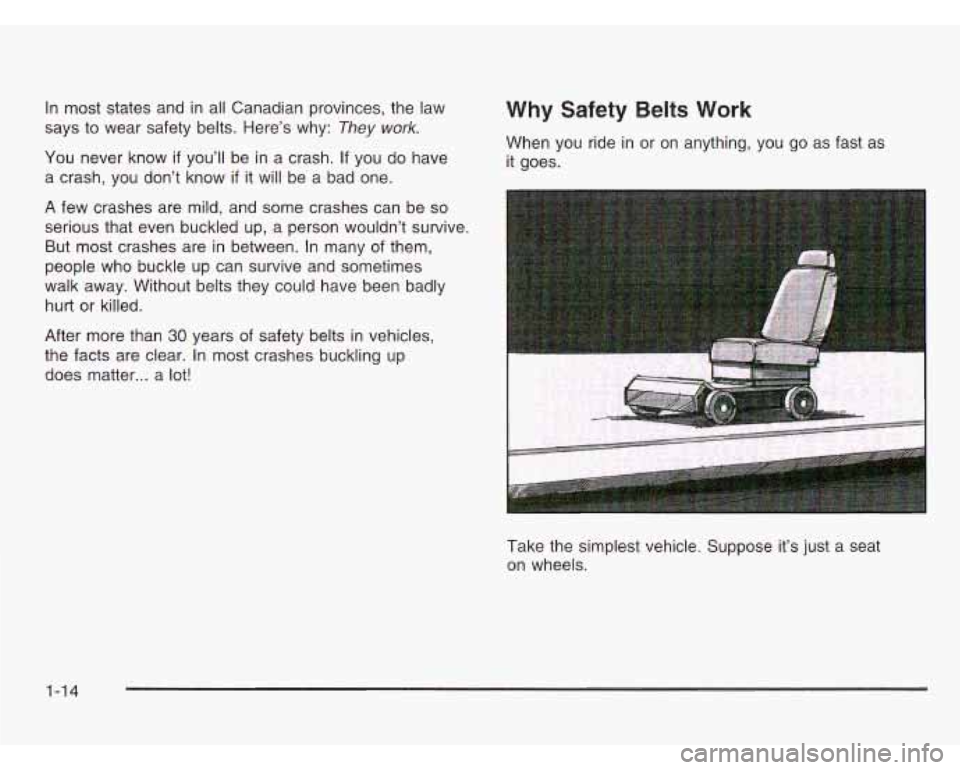
![CHEVROLET ASTRO 2003 Owners Manual Sic-1
I! uo au0aUlos ]nd CHEVROLET ASTRO 2003 Owners Manual Sic-1
I! uo au0aUlos ]nd](/img/24/55882/w960_55882-21.png)
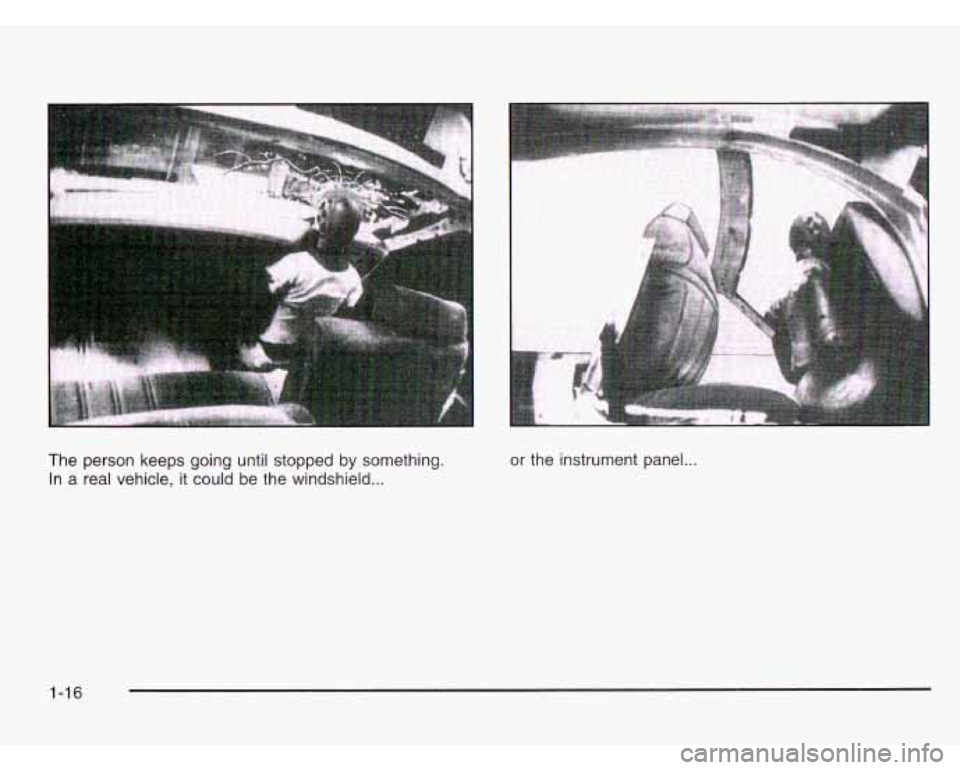


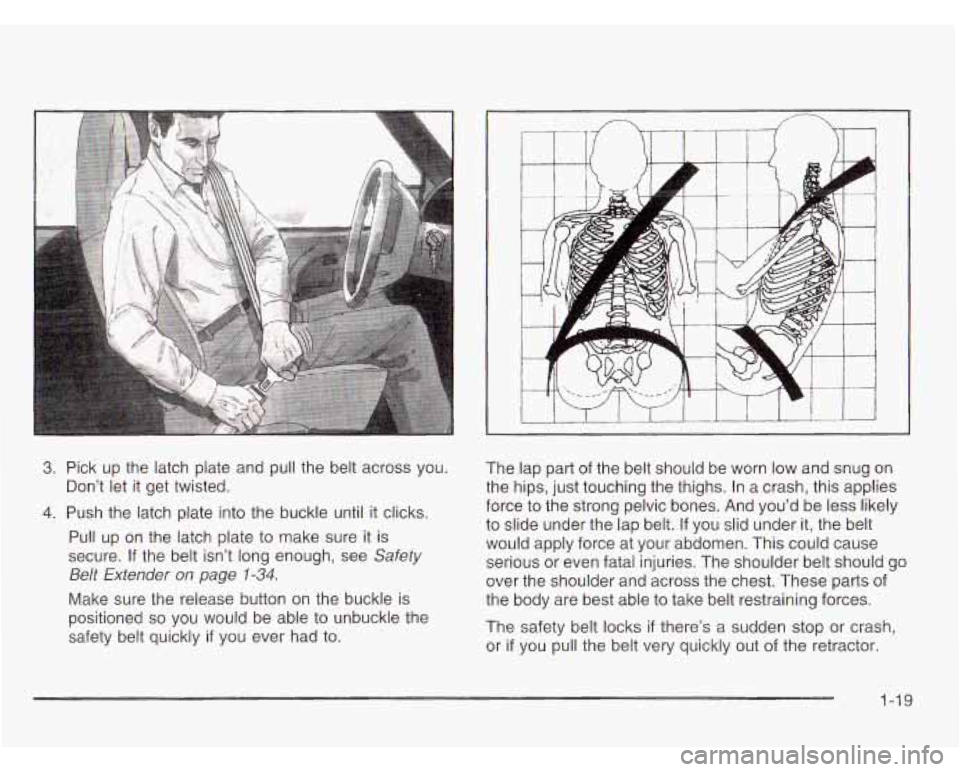
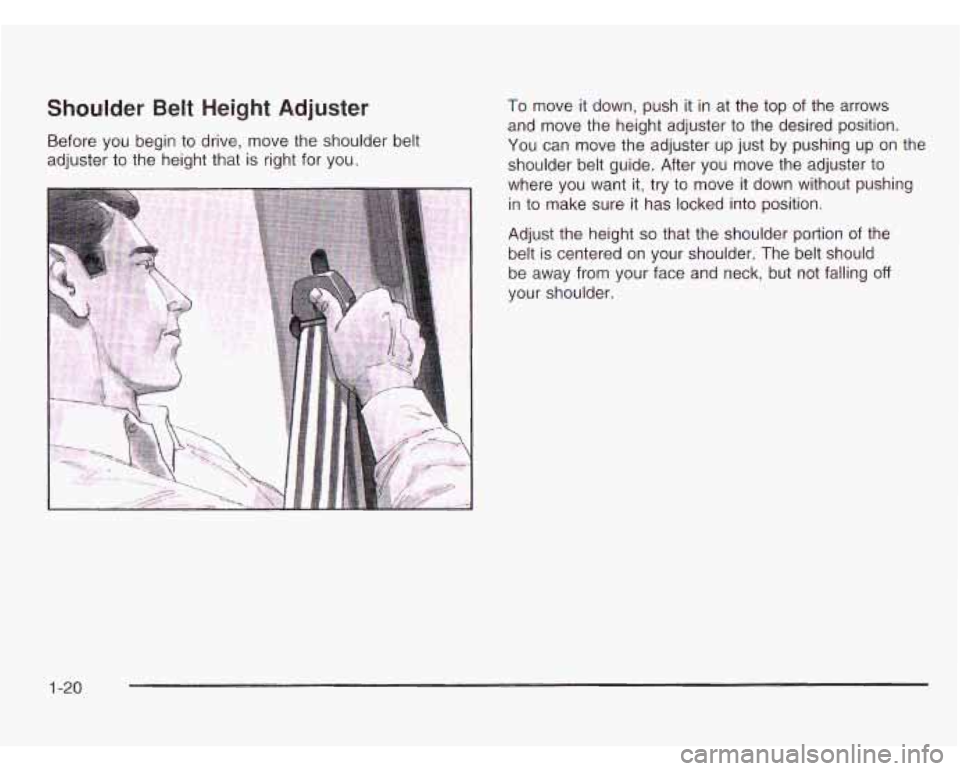
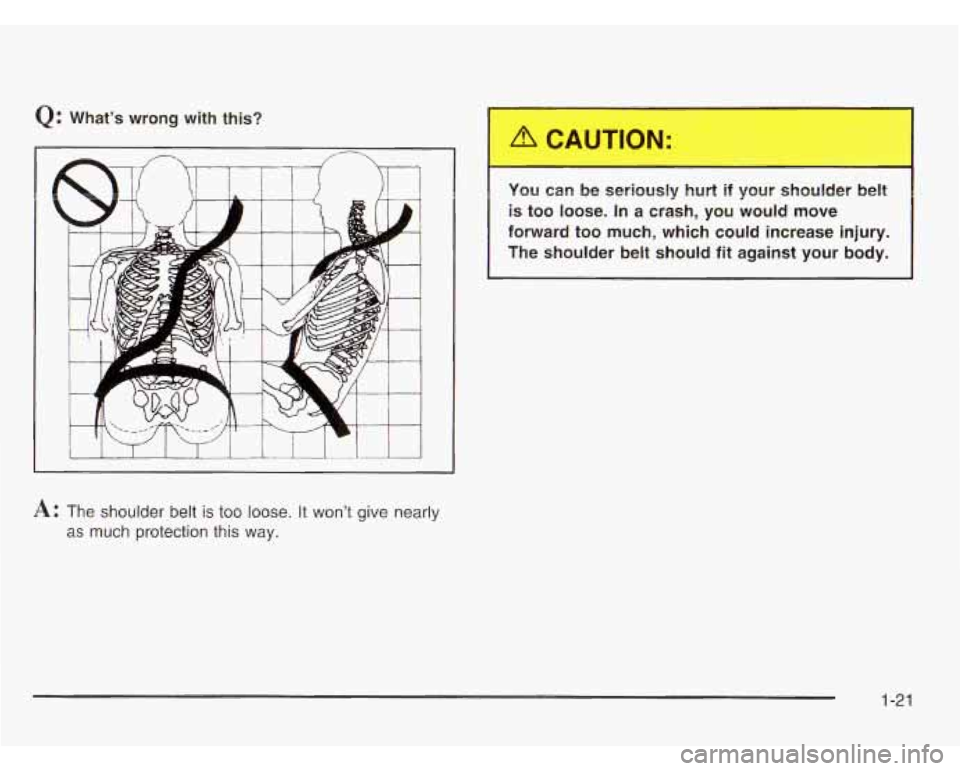
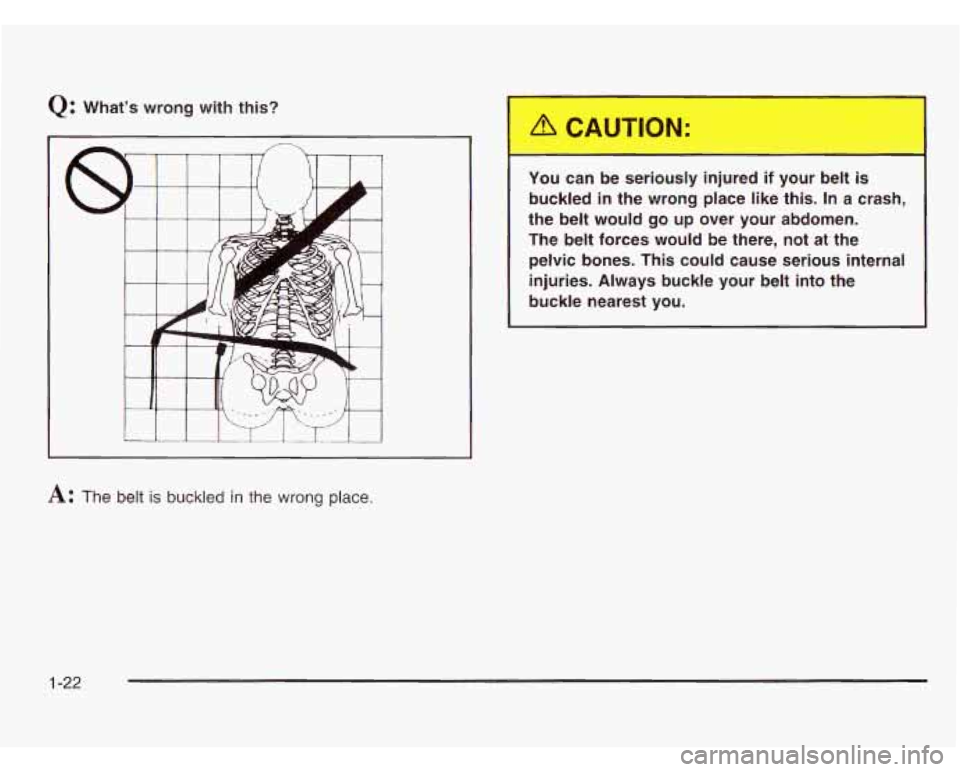


![CHEVROLET ASTRO 2003 Owners Manual Sic-1
I! uo au0aUlos ]nd CHEVROLET ASTRO 2003 Owners Manual Sic-1
I! uo au0aUlos ]nd](/img/24/55882/w960_55882-21.png)







